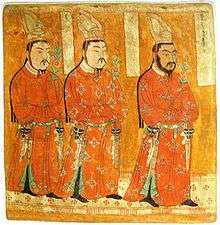Kara Del
Kara Del or Qara Del was a Mongol kingdom that existed in Hami in present-day Xinjiang. It was founded by the Yuan prince Gunashiri, a descendant of Chagatai Khan, in the late 14th century (c.1389), and ruled by the Chagatayids thereafter until 1463. From 1380, it began to tribute to Ming dynasty. From 1406, it was governed by Ming under the Kara Del Guard (Chinese: 哈密卫), however sometimes it was still under the influence of Northern Yuan, and the ruler was called the Obedient King (Chinese: 忠顺王) under the Jimi system. It was destroyed as a result of the wars between Ming China and Oirat Mongols and dynastic succession struggles in 1513. Kara Del means "Black chest" in the Mongolian language.
Kara Del 哈密卫 | |||||||||||
|---|---|---|---|---|---|---|---|---|---|---|---|
| c. 1389–1513 | |||||||||||
 Location of Kara Del | |||||||||||
| Capital | Hami | ||||||||||
| Common languages | Mongolian, Old Uyghur language | ||||||||||
| Government | Monarchy | ||||||||||
| Khan | |||||||||||
| Historical era | Post-classical | ||||||||||
• Gunashiri breaks away from Northern Yuan dynasty | c. 1389 | ||||||||||
• Kara Del accepts Ming supremacy | 1404 | ||||||||||
• Conquered by Esen of the Northern Yuan dynasty based in Mongolia proper | 1430s | ||||||||||
• Coup staged by pro-Mongol faction | 1463 | ||||||||||
• Ming restores Gunashiri dynasty | 1467 | ||||||||||
• Mansur Khan from the Chagatai Khanate overthrew the Gunashiri dynasty and the region's conversion to Islam | 1513 | ||||||||||
| |||||||||||
| Today part of | China | ||||||||||
Part of a series on the |
|---|
| History of Xinjiang |
 |
|
Medieval and early modern period |
History
In 1389, the Buddhist Chagataid prince Gunashiri broke away from the Northern Yuan dynasty, which had fallen under the reign of Jorightu Khan Yesüder, an Arig-Bokid prince. He established himself in Hami by 1390 and ruled over a Uyghur population.[1][2]
In 1404, Gunashiri's successor Engke Temiir accepted the establishment of a Ming guard and became Hami Prefecture.[2] However the Ming did not directly govern Hami or collect taxes. Engke Temiir was granted the title Zhongshunwang (meaning the obedient prince) by the Ming court.[3] During the 1430s, Kara Del submitted to the Oirats. The Uyghurs of Hami came into regular contact with Mongols in southwestern Inner Mongolia. Several Uyghur chiefs became major leaders of the western Mongols, leading to the spread of Uyghurjin as a clan name in the Ordos area.[2]
In 1463 the khan was overthrown by a pro-Mongol faction and a serious succession crisis ensued. From 1467, the Ming emperors repeatedly reinstalled members of Gunashiri's house but the situation in Hami never stabilized. Hami was conquered by Mansur Khan, the ruler of Moghulistan in 1513.[2] Kara Del officially converted to Islam in 1513.[4]
It was reported that between Khitay and Khotan the Sarigh Uyghur tribes who were "impious" resided, and they were targeted for ghazat (holy war) by Mansur Khan following 1516.[5][6] After the islamization of Kara Del, Uyghur fell into disuse until the 20th century, except as a local term for Muslim Turks in Hami and Turpan. In 1923, Uyghur was revived again as a general designation for Xinjiang's Tarim Basin oasis dwellers.[2]
Culture
Buddhism survived in Uyghurstan (Turfan and Qocho) during the Ming dynasty.[7]
List of rulers of Kara Del
According to Japanese Wikipedia (ja:グナシリ):
- Unaširi (兀納失里) (1380–1393)
- Engke Temür (安克帖木兒) (1393–1405) (He was vassal of China since June 1404)
- Toqto (脫脫 (哈密國) (1405–1411) (He was vassal of China)
- Mengli Temür (免力帖木兒) (1411–1425) (He was vassal of China)
- Budaširi (卜答失里 Bo Dá Shī Lǐ) (1425–1439) (He was firstly vassal of China, later of Northern Yuan dynasty). He was rivalled firstly Toγon Temür (脱欢帖木儿) (1427–1437) and Toqto Temür (脱脱塔木儿) (1437–1439), the son of rival.
- Khalīl sulṭān (哈力锁鲁檀) (1439–1457) (He was vassal firstly of Northern Yuan dynasty till 1455, later of China)
- Bürege (卜列革) (1457–1460)
Rivalry between Nugandaširi (努溫答失里) (1460–1472) and Baγ Temür (把塔木儿) (1466–1472)
- Qanšin (罕慎) (1472–1488)
- Engke Bolad (奄克孛剌) (1488–1492) and (1493–1497)
- Šamba (陕巴) (1492–1493) and (1497–1505)
- Beyazıt (拜牙即) (1505–1513)
See also
- Kingdom of Qocho
- Ming–Turpan conflict
- Islamicisation and Turkicisation of Xinjiang
References
- Ed. Reuven Amitai-Preiss, Reuven Amitai, David Morgan-The Mongol empire and its legacy, p.294
- Atwood 2004, p. 564.
- Kim 2008, p. 68.
- Betta, Chiara (2004). The Other Middle Kingdom: A Brief History Of Muslims In China. University of Indianapolis Press. p. 9. ISBN 978-0-88093-853-2.
- Tōyō Bunko (Japan) (1986). Memoirs of the Research Department. p. 3.
- Tōyō Bunko (Japan); Tōyō Bunko (Japan). (1983). Memoirs of the Research Department of the Toyo Bunko: (the Oriental Library). Tôyô Bunko. p. 3.
- Saintly Brokers: Uyghur Muslims, Trade, and the Making of Qing Central Asia, 1696--1814. ProQuest. 2008. pp. 75–. ISBN 978-1-109-10126-3.
Bibliography
- Atwood, Christopher P. (2004), Encyclopedia of Mongolia and the Mongol Empire, Facts On File